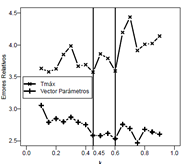Choosing the Weighting Constant in Compound Optimal Designs: cD-optimal Designs
Main Article Content
Keywords
Optimal experimental designs, information matrix, Efficiency, D-optimality, c-optimality, compound optimal design, power test, relative error.
Abstract
Two alternative methods for choosing the weighting constant in cD-optimal designs are proposed. The methods are based on power hypothesis testing associated with both the significance of model parameters under study as the significance of a nonlinear function of interest. The two methodologies and the existing methodology in the literature (efficiencies methodology) are described. With an example, the weighting constant is found with methodologies proposed and is compared with the methodology of efficiencies. cD-optimal designs with higher powers, small relative errors and even better than the optimal designs with the efficiencies methodology are obtained.
MSC: 62K05; 62K99
Downloads
References
[2] V. López Ríos and R. Ramos Quiroga, “Introducción a los diseños óptimos”, Revista Colombiana de Estadística, vol. 30, no. 1, pp. 37–51, 2007. [Online]. Available: http://www.emis.de/journals/RCE/V30/V30-1-37LopezRamos.pdf
[3] A. C. Atkinson, “The usefulness of optimum experimental design”, Journal of the Royal Statistical Society. Serie B (Methodological), vol. 58, no. 1, pp. 59–76, 1996. [Online]. Available: http://www.jstor.org/stable/2346165
[4] Y. C. Huang and W. K. Wong, “Multiple-objective optimal designs”, Journal of Biopharmaceutical Statistics, vol. 8, no. 4, pp. 635–643, 1998. [Online]. Available: http://dx.doi.org/10.1080/10543409808835265
[5] Z. Wei and W. K. Wong, “Multiple-objective designs in a dose response experiment”, Lecture Notes Monograph Series, vol. 34, pp. 73–82, 1998. [Online]. Available: http://www.jstor.org/stable/4356063
[6] H. Dette, A. Pepelyshev, and W. K. Wong, “Optimal designs for dose-finding experiments in toxicity studies”, Bernoulli, vol. 15, pp. 124–145, 2009. [Online]. Available: 10.3150/08 BEJ152
[7] A. Biswas and P. Chaudhuri, “An efficient design for model discrimination on parameter estimation in linear models”, Biometrika, vol. 89, no. 3, pp. 709–718, 2002. [Online]. Available: http://biomet.oxfordjournals.org/content/89/3/709.short
[8] Y. C. Huang and W. K. Wong, “Sequential construction of multiple-objective optimal designs,” Biometrics, vol. 54, pp. 1388–1397, 1998.
[9] T. E. O´Brien and J. O. Rawlings, “A nonsequential design procedure for parameter estimation and model discrimination in nonlinear regression models”, Journal of Statistical Planning and Inference, vol. 55, no. 1, pp. 77–93, 1996. [Online]. Available: http://www.sciencedirect.com/science/article/pii/0378375895001824
[10] A. Atkinson and A. Donev, Optimal Design of Experiments. New York: Oxford, 1992.
[11] D. R. Cook and W. K. Wong, “On the equivalence of the constrained and compound optimal design”, Journal of the American Statistical Association, vol. 89, no. 426, pp. 687–692, 1994. [Online]. Available: http://www.jstor.org/stable/2290872
[12] A. Atkinson, A. Donev, and R. Tobias, Optimum Experimental Designs, with SAS. New York: Oxford, 2007.
[13] R. Martín Martín, “Construcción de diseños óptimos para modelos con variables no controlables”, Tesis de Doctorado, Universidad de Castilla-La mancha, España, 2006. [Online]. Available: https://ruidera.uclm.es/xmlui/handle/10578/972
[14] V. López Ríos, “Diseños óptimos para discriminación y estimación en modelos no lineales”, Tesis de Doctorado, CIMAT, México, 2008. [Online]. Available: http://probayestadistica.cimat.mx
[15] W. K. Wong and M. Moerbeek, “Multiple objetive optimal designs for the hierarchical linear model”, Journal of Official Statistics, vol. 18, no. 2, pp. 291–303, 2002. [Online]. Available: http://igitur-archive.library.uu.nl/fss/2010-0607-200156/UUindex.html
[16] W. Zhu, H. Ahn, and W. K. Wong, “Multiple-objective optimal designs for the logit model”, Communications in Statistics - Theory and Methods, vol. 27, no. 6, pp. 1581–1592, 1998. [Online]. Available: http://dx.doi.org/10.1080/03610929808832178
[17] C. Flórez, “Una alternativa para elegir la constante de ponderación en diseños Óptimos compuestos”, Tesis de Maestría, Escuela de Estsdística Universidad Nacional de Colombia-Medellín, Colombia, 2012. [Online]. Available: http://www.bdigital.unal.edu.co/8509/
[18] I. Lorens and W. K. Wong, “A graphical method for finding maximin efficiency designs”, Biometrics, vol. 56, no. 1, pp. 113–117, 2000. [Online]. Available: http://www.jstor.org/stable/2677110
[19] F. Pukelsheim, Optimal Design of Experiments. New York: John Wiley and Sons, 1993.
[20] S. Huet, A. Bouvier, M. Poursat, and E. Jolivet, Statistical Tools for Nonlinear Regression: A practical Guide with S-Plus and R- Examples. New York: Springer, 2004.
[21] R Development Core Team, R: A Language and Environment for Statistical Computing, R Foundation for Statistical Computing, Vienna, Austria, 2011, ISBN 3-900051-07-0. [Online]. Available: http://www.R-project.org/

